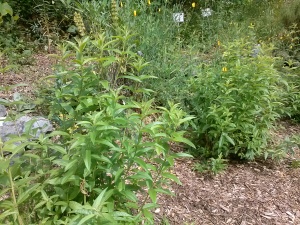Mulch? What is it? Why use it? How to use it?
By Christopher Harrod
With the rise of the suburban landscapes, there has been an increased focus on manicured landscaping. When leaves fall on the ground or lawn, they are raked, bagged, and sent to some another place. These leaves would naturally provide the soil with what would be considered “organic mulch,” (I’ll explain later). Mulches like leaves help reduce evaporation, increase organic matter in the soil, and improve drainage. In our Mediterranean climate where we have no rain in the summer, mulch should be in wide use, helping conserve our water.
Why use mulch? First of all, it’s putting money back into your pocket by saving you on your water bill. It also provides organic matter that eventually breaks down to humus, which provides nutrients and stimulates biological activity. Also, the organic matter improves soil drainage in clay soils and increases water-holding capacity in sandy soils. Mulches also help reduce weeds by smothering and blocking sunlight to seeds. They also make it a whole lot easier to pull weeds when you do have them because the soil is nice and loose.
What are the different types of mulches? They are mainly divided into three categories: organic, inorganic, and living. Organic mulches would include wood chips, straw, newspaper, etc. Inorganic mulches would include rocks like river stones, sand or lava rocks. Living mulches would be plants, mostly plants that spread and form a dense cover above the soil. A few plants that I recommend include comfrey, thyme, and low growing California natives such as Manzanita (Arctostaphylos sp.) or California Lilac (Ceanothus sp.). California Lilac and Manzanita are the most drought and deer resistant. While, comfrey (high in potassium) can be cut multiple times a season for nutrient rich mulch.

There are lots of choices when it comes to applying mulch in your yard. How do you choose one for your landscape? The organic and living mulches provide the most benefits. The inorganic mulches do not provide organic matter but are great when used with succulents, cacti and other seaside and desert plants. Straw is great for vegetable gardens, because it breaks down relatively fast. For orchards, you may want to go with wood chips cut into different sizes that will provide weed control for a longer period. Pine needles and oak leaves work great for acid loving plants. There are many resources online that are easy to access that can provide more information on choosing your mulch.
There are certain guidelines you want to follow when applying mulch to your landscape. First of all, it’s important not to cover the crown of the plant because this can cause moisture to build up around the trunk, which will result in crown rot. Horticulturalists have different opinions on how much mulch should be applied. Through my experience and research, I believe a couple inches or less is all you need in most situations. If mulching summer vegetables, wait until mid-spring because you want the soil to be warm. Also, be sure to water the mulch after you apply because sometimes it can be very dry, acting as a barrier to water.
Finding materials for mulch in Sonoma County is easy, local soil yards like Sonoma Compost will usually have a few options to choose from. Also, at local nurseries, you can find bagged mulch. Wood chips are sometimes offered for free on sites such as Craigslist and Freecycle. The easiest option would be to let the leaves and branches from your own plants decompose on site. That method doesn’t require you to get in your car or pull out your rake on your day off.
Useful Links:
Benefits of Mulch Pamphlet (PDF)
University of Illinois Extension (Great description list of mulches)